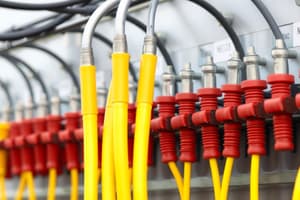Podcast
Questions and Answers
What does Table 1 represent?
What does Table 1 represent?
- Radius of Conduit and Tubing Bends
- Percent of Cross Section of Conduit and Tubing for Conductors and Cables (correct)
- Dimensions of Insulated Conductors and Fixture Wires
- Conductor Stranding
What is described in Table 2?
What is described in Table 2?
- Conductor Properties
- Dimensions and Percent Area of Conduit and Tubing
- Percent of Cross Section of Conduit and Tubing for Conductors and Cables
- Radius of Conduit and Tubing Bends (correct)
Which table outlines dimensions and percent area of conduit and tubing?
Which table outlines dimensions and percent area of conduit and tubing?
- Table 11(A)
- Table 5
- Table 4 (correct)
- Table 9
What does Table 5A depict?
What does Table 5A depict?
What type of data does Table 9 provide?
What type of data does Table 9 provide?
Which table is related to Class 2 and Class 3 power source limitations?
Which table is related to Class 2 and Class 3 power source limitations?
What are the conductor properties detailed in Table 8?
What are the conductor properties detailed in Table 8?
What limitations does Table 12(B) address?
What limitations does Table 12(B) address?
Flashcards
Table 1
Table 1
Percent of Cross Section of Conduit and Tubing for Conductors and Cables.
Table 2
Table 2
Radius of Conduit and Tubing Bends.
Table 4
Table 4
Dimensions and percent area of conduit and tubing.
Table 5A
Table 5A
Signup and view all the flashcards
Table 9
Table 9
Signup and view all the flashcards
Table 11(A)
Table 11(A)
Signup and view all the flashcards
Table 8
Table 8
Signup and view all the flashcards
Table 12(B)
Table 12(B)
Signup and view all the flashcards
Study Notes
NEC Chapter 9 Tables Overview
- Table 1: Provides the percent of the cross section for various conduits and tubing used for conductors and cables.
- Table 2: Offers information on the radius measurements for bends in conduits and tubing.
- Table 4: Lists dimensions and percent areas specifically for conduits and tubing, accommodating combinations of wires as per Table 1.
- Table 5: Details the dimensions for insulated conductors and fixture wires, guiding appropriate installation.
- Table 5A: Contains nominal dimensions and areas for compact copper and aluminum building wires, essential for sizing calculations.
- Table 8: Compiles properties of conductors, which are critical for understanding electrical characteristics and safety.
- Table 9: Displays alternating-current resistance and reactance values for 600-volt cables under specific conditions (3-phase, 60 Hz, temperature up to 75°C).
- Table 10: Describes the stranding of conductors, important for flexibility and current carrying capacity.
- Table 11(A): Defines limitations for Class 2 and Class 3 alternating-current power sources, vital for compliance and safety regulations.
- Table 11(B): Outlines limitations for Class 2 and Class 3 direct-current power sources, ensuring proper application and safety measures.
- Table 12(A): Sets forth PLFA (Power Limited Fire Alarm) alternating-current power source limitations, necessary for fire alarm systems.
- Table 12(B): Specifies PLFA direct-current power source limitations, helping regulate fire alarm circuit integrity and performance.
Studying That Suits You
Use AI to generate personalized quizzes and flashcards to suit your learning preferences.




